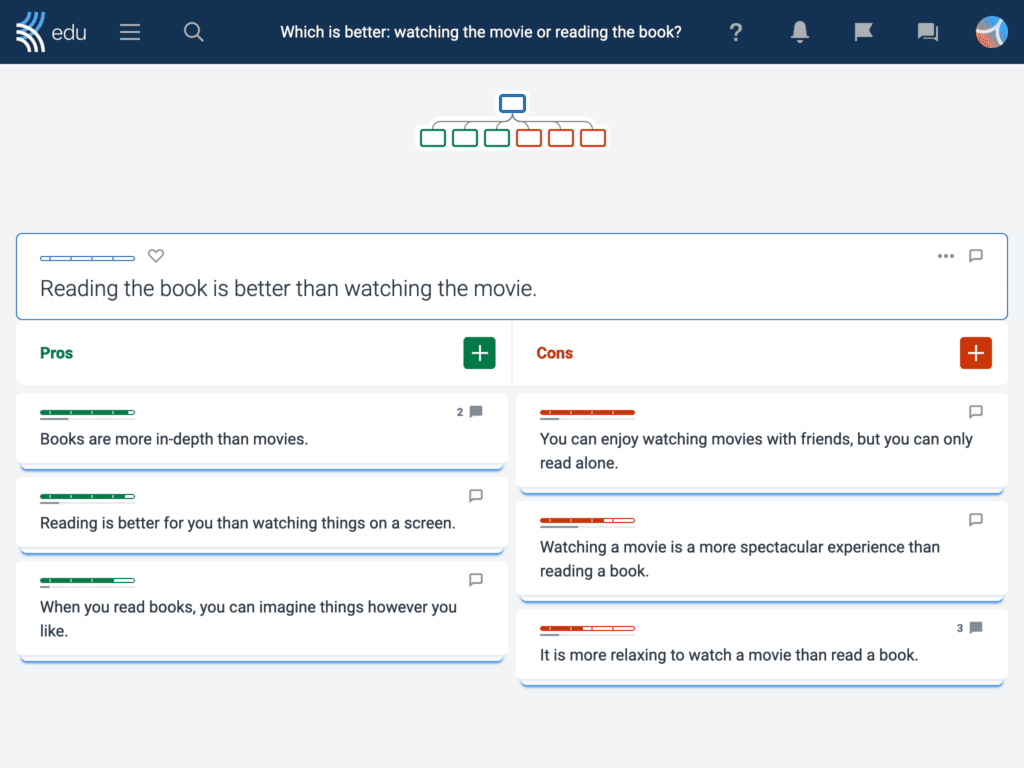When you have an in-person class discussion with your students, you always want to make sure to not only choose a great debate topic, but to also have some prompts to get things going. This is no different when holding a discussion on Kialo Edu, where establishing some ideas beforehand will help steer your students in the right direction.
In this case, your top-level claims (those directly under the thesis) would be your class discussion prompts. With the right top-level claims, you can set up your students to dive right into the most important arguments — and what better way to try this out on Kialo Edu today by heading over to our Topic Library, where we’ve got more than 500 debate topics ready-to-go with some top-level claims?
What are “top-level claims” on Kialo Edu and how do I write them?
Top-level claims are the claims that appear at the very top of the discussion tree, just below the thesis. Here, we can see a discussion with six top-level claims: three pro claims that support the thesis, and three con claims that rebut the thesis.
Below each top-level claim are further claims. These claims act as sub-claims to the claim above, and can present many different lines of reasoning, creating a wide-branching discussion.

Given Kialo Edu’s logical structure, top-level claims determine all the possible lines of discussion that might happen beneath them. This is why it is helpful to think of top-level claims as prompts to help students kick off a discussion.
So, how exactly do you come up with top-level claims that act as great class discussion prompts?
How to formulate top-level claims that are highly debatable
Of course, a good class discussion prompt is one that will prompt a good class discussion. For this reason, top-level claims should be highly debatable, inviting many arguments for or against.
1. Make top-level facts debatable opinons, rather than facts
Thus, it is best to avoid ironclad facts. Instead, top-level claims should offer up opinions, contested ideas, or disputable assertions that can stimulate plenty of support and counterexamples. Generally, you’ll find you’ll want lots of space for back-and-forth argumentation under your claims at the top level!
In the end, if you think your students will have plenty to say about it, it’s got the makings of a good top-level claim. Here, we see six top-level claims under a thesis. These top-level claims consist of opinions and qualified assertions that are highly debatable, which act as effective class discussion prompts.

2. Think of top-level claims like big “umbrellas”
A good top-level claim, like a good discussion prompt, is the starting point for many other ideas. So, when you’re coming up with a top-level claim, try to make it into the biggest “umbrella” that you can: one core argument that can encompass many subsidiary arguments.
In the example below, we have the top-level claim “Books are more in-depth than movies” underneath the thesis of “Reading the book is better than watching the movie.” This top-level claim acts as an effective “umbrella” for more focused, subsidiary lines of argumentation underneath.

With this in mind, you won’t need very many top claims to prompt a lively class discussion. Having a few solid top-level claims encourages students to add claims in logical lines of argumentation and thereby deepen the discussion.
3. Ensure top-level claims offer quality arguments
Top-level claims are most effective as discussion prompts if they’re logically sound, well-worded, and offer a balance of ideas from the start. For this reason, top-level claims should offer quality arguments that students can build on.
First off, ensure some sort of equilibrium among the top-level pro and con claims. For example, avoid having several top-level pros and but only one top-level con. If your top-level claims are skewed to one side, students may understandably feel like there is less to say about the other side of the discussion. If key arguments for one side aren’t represented in your top-level claims, students may be less likely to explore those arguments.
4. Make top-level claims represent different perspectives
Moreover, top-level claims should also represent different perspectives in good faith. If an argument is patently flimsy, it leaves little room for support and takes little effort to refute. Of course, that’s no way to kick off a class discussion! Therefore, it’s a good idea to vet your top-level claims for common logical fallacies, so that you have the strongest possible foundation for conducting a class discussion.
We hope that these tips will help you to understand the parallel between top-level claims on Kialo Edu and more traditional class discussion prompts. If you haven’t already, sign up for a free account and start using Kialo Edu for your classroom discussions. We’d love to hear how you’ve created top-level claims for your class, so please do share with us your experience at feedback@kialo-edu.com, or on social media!

